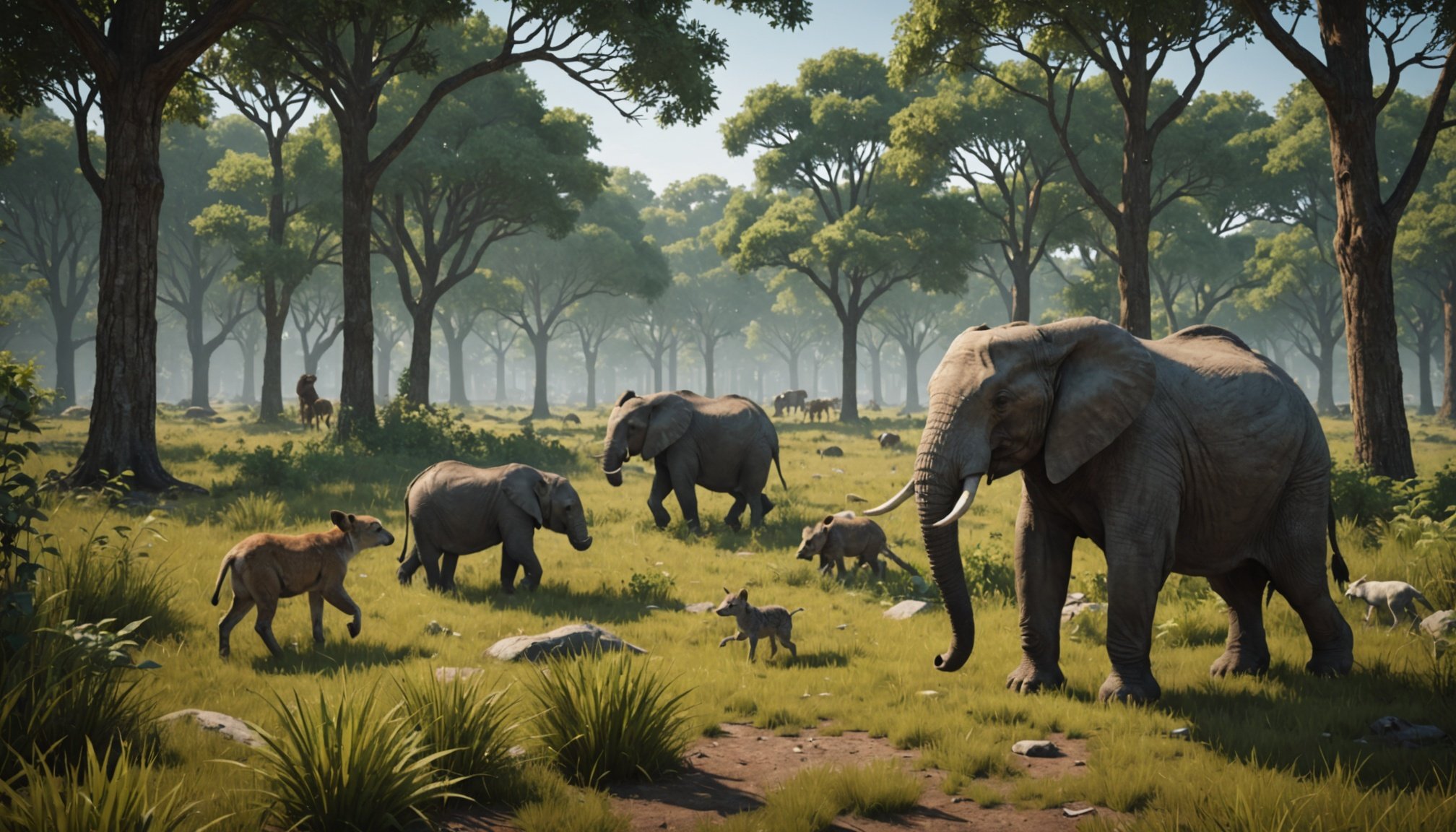Introduction to AI in Wildlife Simulation
Artificial intelligence is reshaping wildlife simulations by creating models that mimic the complexities of actual wildlife behavior. This integration of AI is pivotal in providing enhanced realism, which is crucial for applications like ecological research, conservation planning, and education. By replicating realistic behavior, these simulations allow researchers to observe how various species interact within their ecosystems and respond to environmental changes.
AI’s role in modeling wildlife behavior includes developing algorithms that can predict and simulate the intricate dynamics of animal movements and interactions. These advanced models provide insights that are not easily achievable through traditional observation methods, enabling scientists to test hypotheses in a controlled and repeatable manner. The importance of realism in wildlife simulations cannot be understated, as it ensures the results are applicable to real-world scenarios.
Also to discover : Mastering ai: innovative tactics for developers to create engaging and immersive in-game experiences
Recent advancements in AI technologies have furthered these capabilities, allowing for more sophisticated and realistic behavior modeling. Machine learning and neural networks have been instrumental in refining these simulations, helping to capture the subtle nuances of wildlife dynamics. Such developments promise to enhance our understanding of ecosystems, contributing significantly to conservation efforts and educational initiatives.
AI Technologies Used in Wildlife Simulations
Harnessing the power of AI technologies in wildlife simulations ushers in a new era of understanding and monitoring animal ecosystems. Central to this transformation is the deployment of machine learning, enhancing our ability to simulate and predict wildlife behaviour accurately.
Also read : Revolutionizing in-game economies: harnessing machine learning to enhance financial systems for gamers
Machine Learning Algorithms
Machine learning algorithms, particularly supervised and unsupervised learning, play a pivotal role in wildlife simulations. Supervised learning involves training a model on a labeled dataset, like known animal movement patterns, to predict future behaviours. In contrast, unsupervised learning helps uncover hidden structures within the data, such as clustering animals based on similar movement traits. A noteworthy case study is the use of these algorithms in tracking migratory birds, revealing patterns that aid in conservation strategies.
Behavioral Modeling Techniques
AI technologies simulate animal movements by defining intricate dynamic interaction protocols. These protocols help create realistic models of how animals interact within their environments, accounting for various factors such as terrain and weather. By simulating these elements, researchers can better predict shifts in animal behaviour and populations in response to environmental changes.
Simulation Software Platforms
There are several popular simulation software platforms that employ AI technologies. These platforms offer diverse features such as real-time data analysis and visualization tools. By comparing these platforms’ functionalities, users can select the one best suited for their simulation needs, balancing complexity with usability.
Case Studies Showcasing Authentic Animal Behavior
Understanding authentic behavior in animals is pivotal for wildlife conservation and research. Case studies often involve detailed examinations of specific wildlife simulation projects that aim to mirror these behaviors accurately. Such projects utilize AI technology to delve deeper into the dynamics of animal interactions and environments.
For instance, AI can simulate the intricate patterns of predator-prey interactions in savannas. By doing so, researchers gain insights that are otherwise challenging to observe directly. These case studies have uncovered significant information, like how changes in prey populations affect predator strategies.
The outcomes and impacts of deploying AI in understanding animal behavior extend beyond research findings. This technology aids in enhancing biodiversity and ecosystem management by providing real-time data. Such insights empower conservationists to make informed decisions to preserve habitats.
Reflecting on lessons learned from these AI-enhanced simulations, one key takeaway is the importance of interdisciplinary collaboration. Combining biology, computer science, and environmental studies ensures a comprehensive approach. Moreover, it’s evident that AI doesn’t replace traditional methods but complements them by offering new perspectives and solutions.
Traditional vs. AI-Enhanced Simulations
Exploring the traditional simulations and AI enhancement brings a fresh perspective to understanding their distinct features.
Limitations of Traditional Methods
Historically, pre-AI wildlife simulations faced significant challenges. These traditional methods often struggled with realism, making it difficult to accurately replicate complex ecosystem dynamics. Such simulations relied heavily on predefined algorithms, limiting their flexibility and capacity to adapt to unpredictable environmental changes. Moreover, user engagement was hindered by static models, which failed to capture the dynamic nature of animal behaviors and habitats, often resulting in a less immersive experience for users.
Advantages of AI-Enhanced Approaches
In contrast, AI-enhanced simulations offer a significant leap forward. By incorporating AI enhancement, these simulations achieve a higher degree of realism, enabling them to model intricate interactions within ecosystems more effectively. Users note improved engagement due to the dynamic and ever-evolving nature of AI-driven models. Furthermore, AI contributes to more accurate research outcomes, allowing scientists to analyse nuanced data patterns, leading to more reliable conclusions about wildlife responses and behaviors.
User Experiences and Feedback
Feedback from both creators and users highlights the transformative impact of AI-enhanced simulations. Educational programs now benefit from immersive learning environments, enhancing wildlife management techniques. The versatility and realism provided by AI have led to heightened user satisfaction and more effective educational and research programs.
Impacts of Realism on Research and Education
Realism plays a vital role in both research applications and educational impact. In scientific research, realistic simulations allow researchers to model and predict complex phenomena with higher accuracy. These simulations can transform theoretical concepts into visual, testable formats that advance scientific understanding. Realism enhances the study of environments, systems, and behaviours, leading to breakthroughs in fields like climatology, medicine, and engineering.
In education, realism enriches learning experiences by providing students with immersive and interactive tools. For instance, virtual reality simulations allow students to explore historical events or complex biological processes in a way traditional textbooks cannot provide. By engaging multiple senses, these tools deepen comprehension and retention, making abstract concepts more accessible.
The influence of realism extends into conservation efforts and policy-making. Realistic simulations enable policymakers to assess environmental impacts and forecast the outcomes of various conservation strategies. This data-driven approach forms the foundation for informed decisions that balance ecological sustainability with development needs.
In essence, realism in simulations contributes significantly to research applications and educational impact, fostering both innovation and understanding across various domains. Through enhanced precision and contextual comprehension, it propels the pursuit of new knowledge and effective solutions.
Future Developments in AI Wildlife Simulation
The ongoing advancements in artificial intelligence promise exciting opportunities for wildlife conservation efforts. By integrating cutting-edge AI technologies with virtual and augmented reality, we can create immersive simulations that enhance wildlife modeling. These simulations offer the potential to predict and mitigate environmental impacts before they occur.
Emerging Technologies on the Horizon
Future trends indicate that the combination of AI with emerging tools, such as augmented reality, will enable detailed and accurate wildlife simulations. These developments can significantly enhance our ability to model ecosystems, leading to better-informed conservation tactics.
Ethical Considerations in AI Use
The increasing use of AI in wildlife simulations raises ethical concerns. It’s crucial to consider the balance between realism and animal welfare, ensuring simulations do not inadvertently harm wildlife or misrepresent their natural behaviours. Ensuring ethical guidelines are followed is paramount in these simulations.
Collaborative Efforts in Research
Interdisciplinary approaches are essential for the successful integration of AI into wildlife conservation, highlighting the need for collaboration between technologists and conservationists. Collaborative partnerships can drive innovation and maximize the benefits of these technologies, supporting sustained conservation initiatives with fresh insights and practical applications.











